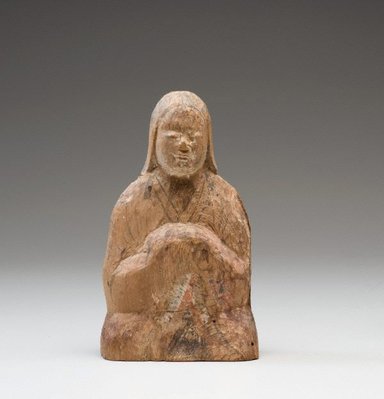-
Details
- Place where the work was made
-
Japan
- Period
- Heian period 794 - 1185 → Japan
- Date
- 12th century
- Media category
- Sculpture
- Materials used
- cypress wood with traces of pigment
- Dimensions
-
a - male deity, 26.5 cm
b - female deity, 21 cm
- Credit
- D G Wilson Bequest Fund 2008
- Location
- Not on display
- Accession number
- 70.2008.a-b
- Copyright
- Share
-
-
About
These small, yet dignified, deities are early examples of the representation of Shintō gods, or kami, in human form. They are rendered here as court nobles: the woman dons Chinese Tang-dynasty style robes and coiffure, while the man wears a tall cap and holds a sceptre, now lost, as a symbol of authority. Shintō sculptures were usually carved out of wood – often from old trees revered as the dwelling places of kami – in what is referred to as the 'single-woodblock technique' or ichiboku-zukuri. Appendages such as hands, feet and hand-held attributes were attached separately. Pigments were then applied to delineate garments, but seldom survive with the passage of time.
In Japan, anthropomorphic representations of kami were unknown before the spread of Buddhism in the 6th century. Even today, representations of deities are hidden away in the inner sanctuary of the Shintō shrines.
Asian Art Department, AGNSW, September 2011
-
Places
Where the work was made
Japan
-
Exhibition history
Shown in 2 exhibitions
Buddha's Smile: Masterpieces of Japanese Buddhist Art, The Okura Shûkokan Museum of Art, , Nov 2002
One hundred flowers (2011), Art Gallery of New South Wales, Sydney, 01 Sep 2011–15 Jan 2012
-
Bibliography
Referenced in 1 publication
-
Buddha's Smile: Masterpieces of Japanese Buddhist Art, Tokyo, Nov 2002. cat.no.51, 52, p.104
-

